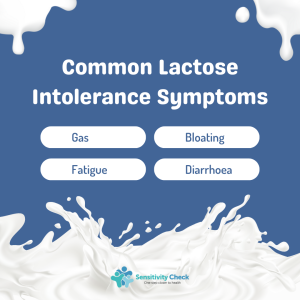Lactose intolerance is a condition that involves your body being unable to digest lactose, a sugar in milk and dairy products. Many people have difficulty digesting lactose. However, not many of them suffer from noticeable symptoms. When you have difficulty digesting lactose, the condition is known as lactose intolerance.
Lactose malabsorption, on the other hand, occurs when your gastrointestinal tract can’t break down or absorb lactose. It’s a common condition considering that about 65% of people worldwide have lactose malabsorption. When lactose is malabsorbed, it can cause symptoms throughout one’s digestive tract.
If one has lactose intolerance, they also have lactose malabsorption. However, not everyone with lactose intolerance has malabsorption. The main difference between these similar conditions is that lactose malabsorption symptoms occur in the small intestines, while lactose intolerance symptoms occur in the colon.
Lactose intolerance causes
Lactase enzymes are produced in the small intestines. They break down lactose into small molecules that can be absorbed through the intestine’s walls. It’s known as lactose intolerance when your body produces too little lactase enzyme such that it can’t break down milk products.
When babies stop breastfeeding or using milk products exclusively, the body naturally starts producing little lactase enzymes. While some people can survive like that, other people’s bodies keep producing fewer and fewer lactase enzymes, which eventually results in lactose intolerance.
Some people are born with lactose intolerance since their bodies naturally can’t produce sufficient lactase enzymes. The number of people born with lactose intolerance is minimal because it is rare. Even children born prematurely, even though at first experience lactose intolerance, eventually start producing sufficient lactase enzymes to break down milk. In premature babies, lactose intolerance occurs because the cells that produce lactase in the stomach aren’t fully formed.
Symptoms of lactose intolerance happen in the large intestines. When you’re lactose intolerant, your lactose isn’t broken down and absorbed in the small intestines. It’s, however, passed into the large intestines. When you have undigested lactose in your large intestines, it causes water production and gas.
Water and gas production also triggers your colon to produce more fluids to help pass undigested food. Gas production occurs because your colon contains bacteria that ferment undigested sugar molecules. This causes symptoms like diarrhoea and pain.
Symptoms of lactose intolerance
Lactose intolerance symptoms vary from one individual to the next regarding the symptoms people experience and their severity. The severity of your lactose intolerance symptoms depends on how much lactose you consume. The more lactose, the more severe your symptoms will be. Common symptoms include:
- Gas
- Diarrhoea
- Joint pain
- Bloating
- Constipation
- Stomach pain
- Fatigue
- Nausea and vomiting
Lactose intolerance symptoms can take a while to appear. That’s because food takes around 6-10 hours to get into your colon after eating. So, it can take longer to leave your body, which might cause your stomach to suffer from symptoms up to two days after consuming lactose.
Lactose is present in most dairy products, not unless they’re listed as “lactose-free.” Cow and goat’s milk contain lactose naturally, and if you’re lactose intolerant, you need to avoid both products. There’s more lactose in some products than others. For example, fresh cream and milk contain higher lactose levels than hard cheeses, which have less.
Because of the difference in lactose levels between different milk products, some people with lactose intolerance can get away with sprinkling cheese on their meals. The best way to determine whether you have lactose intolerance or other food intolerance is by taking an Intolerance Test.
We have an upgrade Ultimate Test that helps you test for lactose intolerance, among other food intolerances. With this test, you’ll have all the common food intolerances tested.
Risk factors of lactose intolerance
Some factors can increase your probability of getting lactose intolerance. These include:
- Age: The older you get, the fewer lactase enzymes the body produces in some people. That’s why it is common to suffer from lactose intolerance as an adult. Lactose intolerance is less common in babies.
- Premature birth: When a child is born before they’re 9 months, it may lack lactase-producing cells because they aren’t fully developed until the third trimester. However, they eventually grow, and your kid stops being lactose intolerant.
- Ethnicity: Lactose intolerance is most common in African, Asian, Hispanic, and american indian descent.
- Diseases that affect the intestines: Conditions affecting the small intestine, like bacterial overgrowth, Crohn’s disease, and celiac disease, often result in lactose intolerance. This occurs because the se conditions damage the intestinal lining, which can reduce lactate production and hence lactose intolerance.
- Some types of cancer treatments: If you’ve been treated with radiation therapy for cancer in your stomach, you may have complications that can often result in issues in your intestines, increasing your risk of developing lactose intolerance.
Can you suddenly develop lactose intolerance?
It is possible to develop lactose intolerance suddenly, especially if you’ve suffered damage to your intestines. Issues like injury, surgery, chronic disease, and infections can damage lactase-producing cells causing you to have less lactate and be unable to digest lactose. This can cause lactose malabsorption or intolerance even if you could digest it before.
You can eliminate lactose intolerance by treating the underlying disease when you have lactose intolerance due to diseases affecting your digestive tract. Treating these diseases can help restore your stomach lining health, resulting in lactase production.
Final thoughts
Lactose intolerance is quite common among adults. It is caused by insufficient lactase enzyme production in the body. Most people develop lactose intolerance as adults because as one grows, they produce fewer lactase enzymes as time goes on. To test for lactose intolerance, we have an upgraded Ultimate Test, which checks for lactose intolerance and other food intolerances.
If you have lactose intolerance, you need to avoid food products containing lactose. Finding lactose-free products in grocery stores is common, and you can purchase these. You can also take lactase enzyme pills which you can find over the counter and help break down lactose so you don’t experience lactose intolerance symptoms.


